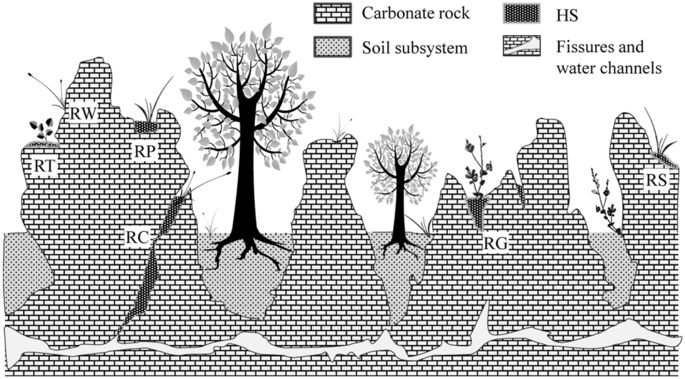Rock outcrop is an important habitat supporting plant communities in karst landscape. Previous studies have concentrated on the ecological significance of vegetation restoration in soil subsystems but data concerning floral changes in rock subsystem are limited, and no study addresses the effects of soil subsystem vegetation on plants of rock outcrops.
Researchers from Xishuangbanna Tropical Botanical Garden (XTBG) investigated the diversity, biomass changes of higher vascular plants (VP) and humus soil (HS) on karst outcrops during a restoration process.
They surveyed vascular plants on rock outcrops and measured humus soil reserved by various rock microhabitats in a rock desertification ecosystem (RDE), an anthropogenic forest ecosystem (AFE), and a secondary forest ecosystem (SFE) in Shilin County, southwest China.
They found that the availability and heterogeneity of HS are important factors for the slow succession of VP since a strong correlation was found between HS and VP metrics. The numbers of individuals, species richness, and biomass of VP were positively related to the amount of HS, canopy coverage, rock outcrops ration, and relative humidity.
HS on rock outcrops was the most important variable to explain the number of individuals, species richness, and biomass.
VP and HS were highly sensitive to the vegetation changes on nearby soil subsystems, and neither of them have improved substantially despite the successful vegetation restoration in soil subsystems.
Humus soil, to some extent, may induce the successful establishment of VP by supplying sufficient water and preventing nutrients leaching into runoff water or seeping through the fissures, and also acts as a medium for roots proliferation. The amount and quality differences in HS patches would increase the heterogeneity of substrate fertility, and significantly influence karst biodiversity.
The study entitled “Humus soil as a critical driver of flora conversion on karst rock outcrops” has been published in Scientific Reports.
Prof. SHEN Youxin Ph.D
Key Laboratory of Tropical Forest Ecology, Xishuangbanna Tropical Botanical Garden, Chinese Academy of Sciences, Mengla, Yunnan 666303, China
Tel: 86-871-65160910
E-mail: yxshen@xtbg.ac.cn

Illustration of the distribution of vascular plants and humus soil on rock outcrops in karst landscapes.
RC: rocky crevice, RG: rocky gully, RP: rocky pit, RS: rocky surface, RT: rocky terrace,
RW: rocky wall, HS: humus soil on rock outcrops.
(Image by ZHU XIai)
Contact
